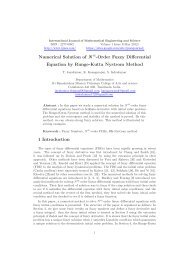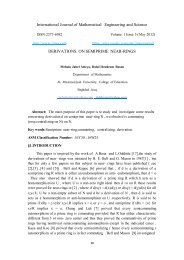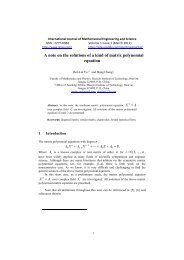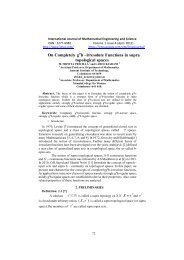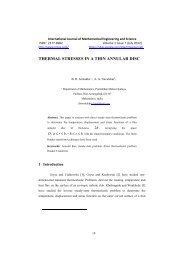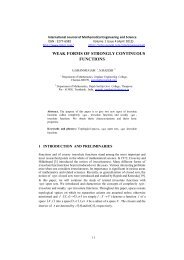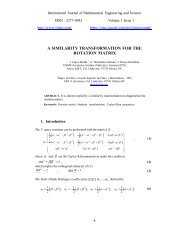Transient Thermoelastic Behavior of Semi-infinite Cylinder by ... - ijmes
Transient Thermoelastic Behavior of Semi-infinite Cylinder by ... - ijmes
Transient Thermoelastic Behavior of Semi-infinite Cylinder by ... - ijmes
You also want an ePaper? Increase the reach of your titles
YUMPU automatically turns print PDFs into web optimized ePapers that Google loves.
International Journal <strong>of</strong> Mathematical Engineering and Science<br />
ISSN : 2277-6982 Volume 1 Issue 5 (May 2012)<br />
http://www.<strong>ijmes</strong>.com/<br />
https://sites.google.com/site/<strong>ijmes</strong>journal/<br />
<strong>Transient</strong> <strong>Thermoelastic</strong> <strong>Behavior</strong> <strong>of</strong> <strong>Semi</strong>-<strong>infinite</strong><br />
<strong>Cylinder</strong> <strong>by</strong> Using Marchi-Zgrablich and Fourier<br />
Transform Technique<br />
Badrinath E. Ghonge 1,1 , Kirtiwant P. Ghadle 1 ,<br />
1<br />
Department <strong>of</strong> Mathematics, Dr. B. A. Marathwada University,<br />
Aurangabad-431004, (M.S.) India.<br />
{badrighonge, drkp.ghadle}@gmail.com<br />
Abstract. The present work deals with transient thermoelastic problem <strong>of</strong> a<br />
semi <strong>infinite</strong> hollow cylinder to determine the temperature, displacement and<br />
thermal stresses with the stated conditions. The transient heat conduction<br />
equation with stated conditions is solved <strong>by</strong> using Marchi-Zgrablich transform<br />
and Fourier Sine transform simultaneously and the results for temperature<br />
distribution, heat flux distribution, displacement and thermal stress functions<br />
are obtained in terms <strong>of</strong> <strong>infinite</strong> series <strong>of</strong> Bessel's function. These results solved<br />
for special case <strong>by</strong> using Math-Cad 2007 s<strong>of</strong>tware and presented graphically <strong>by</strong><br />
using Origin s<strong>of</strong>tware.<br />
Keywords: <strong>Semi</strong>-<strong>infinite</strong> hollow cylinder, <strong>Transient</strong> heat conduction, Thermal<br />
stresses, Marchi-Zgrablich and Fourier Sine transform.<br />
1 Introduction<br />
The <strong>Thermoelastic</strong> problems are one <strong>of</strong> the most frequently encountered<br />
problems <strong>by</strong> scientists. The wide varieties <strong>of</strong> problems that are covered under<br />
conduction also make it one <strong>of</strong> the most researched and thought about problems in the<br />
field <strong>of</strong> engineering and technology. This kind <strong>of</strong> problems can be solved <strong>by</strong> various<br />
methods. These problems consist <strong>of</strong> determination <strong>of</strong> unknown temperature, heat flux,<br />
displacement and thermal stress functions <strong>of</strong> solids when the conditions <strong>of</strong><br />
temperature and displacement and stress are known at the some points <strong>of</strong> the solid<br />
under consideration.<br />
Sirakowski and Sun [1] studied the direct problems <strong>of</strong> finite length hollow<br />
cylinder and determined an exact solution. Grysa and Cialkowski [2] and Grysa and<br />
Kozlowski [3] discussed one dimensional transient thermoelastic problems derived<br />
the heating temperature and the heat flux on the surface <strong>of</strong> an isotropic <strong>infinite</strong> slab.<br />
Further Deshmukh and Wankhede [4] studied an axisymmetric inverse steady state<br />
problem <strong>of</strong> thermoelastic deformation to determine the temperature, displacement and<br />
stress functions on the outer curved surface <strong>of</strong> finite length hollow cylinder. Recently<br />
30
International Journal <strong>of</strong> Mathematical Engineering and Science<br />
ISSN : 2277-6982 Volume 1 Issue 5 (May 2012)<br />
http://www.<strong>ijmes</strong>.com/<br />
https://sites.google.com/site/<strong>ijmes</strong>journal/<br />
Walde and Khobragade [5] obtained the solution for transient thermoelastic problem<br />
<strong>of</strong> finite length hollow cylinder.<br />
In this work we consider semi-<strong>infinite</strong> hollow cylinder. The transient heat<br />
conduction equation is solved <strong>by</strong> using finite Marchi-Zgrablich integral transform as<br />
in Marchi and Zgrablich [6] and Fourier Sine transform as defined in Sneddon [7]<br />
simultaneously and the results for temperature distribution, unknown heat flux,<br />
displacement and thermal stresses are obtained in terms <strong>of</strong> <strong>infinite</strong> series <strong>of</strong> Bessel's<br />
function and it is solved for special case <strong>by</strong> using Mathcad-2007 s<strong>of</strong>tware and<br />
illustrated graphically <strong>by</strong> using Origin s<strong>of</strong>tware.<br />
2 The Mathematical Model<br />
Consider a hollow cylinder occupying space D as define<br />
<br />
<br />
2 2<br />
and as shown in figure 1 below.<br />
D : ( x, y, z) a r x y b,0<br />
z<br />
The thermoelastic displacement function is governed <strong>by</strong> the Poisson’s equation as<br />
in [5]<br />
2 (1 <br />
)<br />
<br />
(1 ) aT t<br />
<br />
(1)<br />
with 0 at r a and r b<br />
(2)<br />
where<br />
2<br />
1<br />
2<br />
2 <br />
, and a<br />
r<br />
2 r r<br />
z<br />
2<br />
t are the Poisson’s ratio and linear<br />
coefficient <strong>of</strong> thermal expansion <strong>of</strong> the material <strong>of</strong> the cylinder and T is the<br />
temperature <strong>of</strong> the cylinder satisfying the differential equation as in Ozisik [8]<br />
2 2<br />
T 1T T 1 T<br />
<br />
2<br />
r r<br />
2<br />
r<br />
z<br />
k t<br />
(3)<br />
subject to the initial condition<br />
T( r, z, t) t0<br />
0<br />
(4)<br />
and the boundary conditions<br />
T ( r, z, t)<br />
<br />
<br />
T( r, z, t) <br />
0<br />
<br />
r<br />
<br />
ra<br />
(5)<br />
T ( r, z, t)<br />
<br />
<br />
T( r, z, t) <br />
0<br />
<br />
r<br />
<br />
rb<br />
(6)<br />
T ( r, z, t)<br />
<br />
<br />
T( r, z, t) <br />
0<br />
<br />
z<br />
<br />
z0<br />
(7)<br />
31
International Journal <strong>of</strong> Mathematical Engineering and Science<br />
ISSN : 2277-6982 Volume 1 Issue 5 (May 2012)<br />
http://www.<strong>ijmes</strong>.com/<br />
https://sites.google.com/site/<strong>ijmes</strong>journal/<br />
T ( r, z, t)<br />
<br />
<br />
T( r, z, t) <br />
0<br />
z<br />
<br />
(8)<br />
<br />
z<br />
where k is the thermal diffusivity <strong>of</strong> the material <strong>of</strong> the cylinder.<br />
The radial and axial displacements U and W satisfying the uncoupled<br />
thermoelastic equations are<br />
2 U 1 (1 )<br />
(1 2 ) e <br />
<br />
U <br />
<br />
2 a T<br />
2 t<br />
(9)<br />
r<br />
r<br />
(1 2 ) r<br />
2 1e<br />
(1 <br />
) T<br />
W (1 2 )<br />
<br />
2 a t<br />
(10)<br />
z<br />
(1 2 ) z<br />
U U W<br />
where e is the volume dilation and<br />
r r z<br />
<br />
U (11)<br />
r<br />
<br />
W (12)<br />
z<br />
The stress functions are given <strong>by</strong><br />
rz ( a, z, t) 0, rz ( b, z, t) 0, rz<br />
( r, z,0) 0,<br />
(13)<br />
and<br />
r ( a, z, t) p1, r ( b, z, t) p0, z<br />
( r,0, t) 0,<br />
(14)<br />
where p 1 and p0<br />
are the surface pressures assumed to be uniform over the boundaries<br />
<strong>of</strong> the cylinder. The boundary conditions for the stress functions (13) and (14) are<br />
expressed in terms <strong>of</strong> the displacement components <strong>by</strong> the following relations:<br />
U U W<br />
r ( <br />
2 G)<br />
r <br />
<br />
<br />
r z<br />
<br />
(15)<br />
<br />
z ( <br />
2 G) W U U<br />
z <br />
<br />
<br />
<br />
r r <br />
<br />
( 2 ) U <br />
G U <br />
<br />
W <br />
<br />
r <br />
r z <br />
<br />
(16)<br />
W<br />
U<br />
rz<br />
G<br />
<br />
<br />
r<br />
z<br />
<br />
(18)<br />
<br />
2G<br />
where is the Lame’s constant, G is the shear modulus and U and W are<br />
1 2<br />
the displacement components. The equations (1) to (18) constitute the mathematical<br />
formulation <strong>of</strong> the problem under consideration.<br />
(17)<br />
32
International Journal <strong>of</strong> Mathematical Engineering and Science<br />
ISSN : 2277-6982 Volume 1 Issue 5 (May 2012)<br />
http://www.<strong>ijmes</strong>.com/<br />
https://sites.google.com/site/<strong>ijmes</strong>journal/<br />
Figure 1: Geometry <strong>of</strong> <strong>Semi</strong>-<strong>infinite</strong> <strong>Cylinder</strong>.<br />
3 The Solution<br />
3.1 Determination Temperature Function T( r, z, t)<br />
Applying finite Marchi-Zgrablich transform [6] to the equation (3), one<br />
obtains<br />
2<br />
2 d T 1 dT<br />
m T (19)<br />
dz<br />
2 k dt<br />
Further applying Fourier Sine transform [7] to the equation (19), one obtains<br />
*<br />
dT 2 *<br />
kp T 0<br />
(20)<br />
dt<br />
p 2 n 2 m<br />
2<br />
where <br />
Equation (20) is the first order linear differential equation, whose solution is given <strong>by</strong><br />
* 2<br />
T C1 . e kp t<br />
(21)<br />
where C 1 is constant.<br />
Applying inversion <strong>of</strong> Fourier Sine transform [7] and Marchi-Zgrablich transform [6]<br />
to the equation (21), we obtain<br />
C ( , , ) 2<br />
<br />
1S sin<br />
0 k1 k2<br />
mr kp t<br />
T nz e<br />
(22)<br />
m 1<br />
m<br />
where S p( k1, k2, mx) J p( mx) G p( k1, ma) Gp( k2, mb)<br />
<br />
Gp ( mx ) J p ( k1 , ma ) J p ( k2<br />
, mb<br />
) <br />
33
International Journal <strong>of</strong> Mathematical Engineering and Science<br />
ISSN : 2277-6982 Volume 1 Issue 5 (May 2012)<br />
http://www.<strong>ijmes</strong>.com/<br />
https://sites.google.com/site/<strong>ijmes</strong>journal/<br />
3.2 Determination <strong>of</strong> <strong>Thermoelastic</strong> Displacement<br />
Substituting the value <strong>of</strong> T( r, z, t)<br />
from equation (22) in equation (1), one obtains<br />
the thermoelastic Displacement ( r, z, t)<br />
function as<br />
2<br />
(1 <br />
) C1S 0( k1, k2, ) 2<br />
( , , ) sin<br />
mr r kp t<br />
r z t at<br />
nz<br />
e<br />
(23)<br />
(1 ) m1<br />
4m<br />
Using equation (23) in equation (11) and (12), one obtains the radial and axial<br />
displacement U and W as<br />
2<br />
(1 <br />
) at<br />
C1S 0( k1, k2, r)<br />
r 2<br />
sin<br />
m kp t<br />
U nz<br />
e<br />
(1 ) 4 m1<br />
m<br />
r 2<br />
<br />
'<br />
mS0 ( k1 , k2 , mr ) 2 rS0 ( k1 , k2<br />
, mr<br />
) <br />
(24)<br />
<br />
<br />
2<br />
(1 <br />
) at<br />
<br />
C1S 0( k1, k2, r)<br />
r 2<br />
cos<br />
m kp t<br />
W n<br />
nz<br />
e<br />
(25)<br />
(1 ) 4 m1<br />
m<br />
3.3 Determination <strong>of</strong> Stress Functions<br />
Using equations (24) and (25) in equations (15) to (18), the stress functions<br />
are obtained as<br />
(1 <br />
) a<br />
2 3 '<br />
2 <br />
t<br />
C<br />
sin <br />
1 kp t <br />
r G nz e 4 r mS0( k1, k2, mr) S0( k1, k2, mr)<br />
(1 ) 4 m1<br />
m<br />
<br />
r 4<br />
( , , )<br />
''<br />
( , , )<br />
4 2<br />
mS0 k1 k2 mr S0 k1 k2 mr r mS0 ( k1, k2, mr)<br />
6 r<br />
2<br />
( , , )<br />
2<br />
( , , ) 4<br />
3<br />
( , , )<br />
'<br />
mS0 k1 k2 mr S0 k1 k2 mr r mS0 k1 k2 mr S0( k1, k2, mr)<br />
(1 <br />
) a<br />
( , , ) 2<br />
<br />
t<br />
C<br />
sin<br />
1rS0 k1 k2<br />
mr<br />
kp t<br />
n <br />
(1 ) 4 m 1<br />
z <br />
<br />
<br />
<br />
<br />
e <br />
<br />
<br />
m<br />
<br />
2 '<br />
r mS0 ( k1 , k2 , mr ) 2 rS0 ( k1 , k2<br />
, mr<br />
) <br />
<br />
2<br />
(1 <br />
) at<br />
<br />
2 C ( , , ) 2<br />
sin<br />
<br />
1S0 k1 k2<br />
mr r kp t<br />
n n<br />
(1 ) 4 m 1<br />
z <br />
<br />
<br />
<br />
e <br />
<br />
<br />
<br />
<br />
m<br />
<br />
<br />
(26)<br />
<br />
2<br />
(1 <br />
) a <br />
2<br />
t 2 C1S 0( k1, k2, mr)<br />
r <br />
kp t<br />
z 2G <br />
n sin n<br />
z<br />
e <br />
<br />
(1 ) 4 m1<br />
m<br />
<br />
(1 <br />
) a <br />
2<br />
t<br />
C1<br />
kp t 3 '<br />
sin n z e 4 r mS0( k1, k2, mr) S0( k1, k2, mr)<br />
(1 ) 4 m1<br />
m<br />
<br />
34
International Journal <strong>of</strong> Mathematical Engineering and Science<br />
ISSN : 2277-6982 Volume 1 Issue 5 (May 2012)<br />
http://www.<strong>ijmes</strong>.com/<br />
https://sites.google.com/site/<strong>ijmes</strong>journal/<br />
2 2 3 '<br />
m 0 1 2 m 0 1 2 m m 0 1 2 m 0 1 2 m<br />
6 r S ( k , k , r) S ( k , k , r) 4 r S ( k , k , r) S ( k , k , r)<br />
(1 <br />
) a <br />
t<br />
C1rS 0( k1, k2, mr)<br />
sin nz<br />
e<br />
(1 ) 4 m1<br />
m<br />
<br />
<br />
r<br />
2<br />
<br />
'<br />
mS0 ( k1 , k2 , mr ) 2 rS0 ( k1 , k2<br />
, mr<br />
) <br />
2<br />
kp t<br />
<br />
(27)<br />
(1 <br />
) a <br />
2<br />
t<br />
C1rS 0( k1, k2, mr)<br />
kp t<br />
<br />
2G sin n<br />
z<br />
e<br />
(1 ) 4 m1<br />
m<br />
2 '<br />
r mS 0 ( k 1 , k 2 , mr) 2 rS 0 ( k 1 , k 2 , mr)<br />
<br />
<br />
(1 <br />
) a <br />
2<br />
t<br />
C1<br />
kp t 3 '<br />
sin n z e 4 r mS0( k1, k2, mr) S0( k1, k2, mr)<br />
(1 ) 4 m1<br />
m<br />
<br />
4 '' 4 2<br />
m 0 1 2 m 0 1 2 m m 0 1 2 m<br />
r S ( k , k , r) S ( k , k , r) r S ( k , k , r)<br />
2 2 3 '<br />
m 0 1 2 m 0 1 2 m m 0 1 2 m 0 1 2 m<br />
6 r S ( k , k , r) S ( k , k , r) 4 r S ( k , k , r) S ( k , k , r)<br />
<br />
2<br />
2<br />
t 2 1 0( 1, 2, m<br />
) kp t <br />
n<br />
sin nz<br />
e <br />
(28)<br />
m1<br />
m<br />
(1 <br />
) a C S k k r r<br />
<br />
(1 ) 4<br />
<br />
<br />
2 ( , , ) ' ( , , )<br />
2<br />
2<br />
<br />
(1 <br />
) a <br />
C rS k k r S k k r r<br />
t<br />
rz G n cosn<br />
z<br />
e<br />
(1 ) 4 m1<br />
m<br />
<br />
(1 <br />
) a <br />
t<br />
C1S 0( k1, k2, mr)<br />
r<br />
ncos<br />
nz<br />
(1 ) 4<br />
<br />
m1<br />
2 '<br />
r mS 0 ( k 1 , k 2 , mr) 2 rS 0 ( k 1 , k 2 , mr)<br />
<br />
<br />
<br />
1 0 1 2 m m 0 1 2 m kp t<br />
m<br />
<br />
2<br />
e<br />
2<br />
kp t<br />
<br />
(29)<br />
4 Special Case and Numerical Results<br />
For the special case semi <strong>infinite</strong> cylinder is made up <strong>of</strong> steel material with inner<br />
radius a 1unit and outer b 2units. A numerical results for equations (22), (23),<br />
(26)-(29) are obtained <strong>by</strong> mathematical s<strong>of</strong>tware Mathcad and are depicted<br />
graphically as shown in following figure 2-7.<br />
35
International Journal <strong>of</strong> Mathematical Engineering and Science<br />
ISSN : 2277-6982 Volume 1 Issue 5 (May 2012)<br />
http://www.<strong>ijmes</strong>.com/<br />
https://sites.google.com/site/<strong>ijmes</strong>journal/<br />
Figure2. Temperature distribution<br />
Figure5. Normal stress distribution<br />
Figure3. Displacement distribution<br />
Figure6. Tangential stress distribution<br />
Figure4. Radial stress distribution<br />
Figure7. rz distribution<br />
5 Conclusion<br />
In this paper, the temperature distribution, displacement and stress functions have<br />
been investigated with the help <strong>of</strong> integral transform techniques. The expressions are<br />
represented graphically.<br />
Figure 2 show the temperature variation in the cylinder along radial directions.<br />
Figure 3 show the displacement develops in the cylinder along radial directions.<br />
Figure 4-7 show the stresses occur in the semi <strong>infinite</strong> cylinder along the radial<br />
directions.<br />
36
International Journal <strong>of</strong> Mathematical Engineering and Science<br />
ISSN : 2277-6982 Volume 1 Issue 5 (May 2012)<br />
http://www.<strong>ijmes</strong>.com/<br />
https://sites.google.com/site/<strong>ijmes</strong>journal/<br />
The results that are obtained can be applied to the design <strong>of</strong> useful structures and<br />
can be use in study <strong>of</strong> oil transport.<br />
References<br />
1. Sierakowski, R. L. and Sun, C. T.: An Exact Solution to the Elastic Deformation <strong>of</strong> A<br />
Finite Length Hollow <strong>Cylinder</strong>, Journal <strong>of</strong> the Franklin Institute, vol. 286, pp. 99-113<br />
(1968)<br />
2. Grysa, K. and Cialkowski, M. J.: On A Certain Inverse Problem <strong>of</strong> Temperature and<br />
Thermal Stress Fields, Acta Mechanica, vol. 36, pp. 169-185 (1980)<br />
3. Grysa, K. and Kozlowski, Z.: One Dimensional Problem <strong>of</strong> Temperature and Heat Flux<br />
Determination at the Surfaces <strong>of</strong> A <strong>Thermoelastic</strong> Slab Part-I, The Analytical Solutions,<br />
Nuclear Engineering and Design, vol. 74(1), pp. 1-14 (1983)<br />
4. Walde, R. T. and Khobragade, N. W.: <strong>Transient</strong> <strong>Thermoelastic</strong> Problem <strong>of</strong> A Finite<br />
Length Hollow <strong>Cylinder</strong>, Canadian Journal <strong>of</strong> Science and Engineering Mathematics, vol.<br />
3(2), pp. 56-60 (2012)<br />
5. Deshmukh, K. C. and Wankhede, P. C.: An Axisymmetric Inverse Steady-State Problem <strong>of</strong><br />
<strong>Thermoelastic</strong> Deformation <strong>of</strong> A Finite Length Hollow <strong>Cylinder</strong>, Far East. J. Appl. Math,<br />
vol. 1(3), pp. 247-253 (1997)<br />
6. Marchi, E. and Zgrablich, G.: Heat Conduction in Hollow <strong>Cylinder</strong> with Radiation, Proc.<br />
Edingburgh Math. Soc., vol. 14(2), pp. 159-164 (1964)<br />
7. Sneddon, I. N.: The Use <strong>of</strong> Integral Transforms, Mcgraw-Hill Company, New York (1972)<br />
8. Ozisik, N. M.: Boundary Value Problem <strong>of</strong> Heat Conduction, International Textbook<br />
Company, Scranton, Pennsylvania (1968)<br />
37



